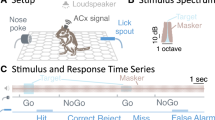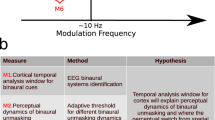Abstract
Behavioral studies in humans suggest that sensorineural hearing loss (SNHL) decreases sensitivity to the temporal structure of sound, but neurophysiological studies in mammals provide little evidence for diminished temporal coding. We found that SNHL in chinchillas degraded peripheral temporal coding in background noise substantially more than in quiet. These results resolve discrepancies between previous studies and help to explain why perceptual difficulties in hearing-impaired listeners often emerge in noisy situations.
This is a preview of subscription content, access via your institution
Access options
Subscribe to this journal
Receive 12 print issues and online access
$209.00 per year
only $17.42 per issue
Buy this article
- Purchase on Springer Link
- Instant access to full article PDF
Prices may be subject to local taxes which are calculated during checkout



Similar content being viewed by others
References
Lorenzi, C., Gilbert, G., Carn, H., Garnier, S. & Moore, B.C.J. Proc. Natl. Acad. Sci. USA 103, 18866–18869 (2006).
Moore, B.C.J., Glasberg, B.R. & Hopkins, K. Hear. Res. 222, 16–27 (2006).
Lorenzi, C., Debruille, L., Garnier, S., Fleuriot, P. & Moore, B.C.J. J. Acoust. Soc. Am. 125, 27–30 (2009).
Harrison, R.V. & Evans, E.F. Arch. Otorhinolaryngol. 224, 71–78 (1979).
Woolf, N.K., Ryan, A.F. & Bone, R.C. Hear. Res. 4, 335–346 (1981).
Miller, R.L., Schilling, J.R., Franck, K.R. & Young, E.D. J. Acoust. Soc. Am. 101, 3602–3616 (1997).
Kale, S. & Heinz, M.G. J. Assoc. Res. Otolaryngol. 11, 657–673 (2010).
Liberman, M.C. & Dodds, L.W. Hear. Res. 16, 55–74 (1984).
Johnson, D.H. J. Acoust. Soc. Am. 68, 1115–1122 (1980).
Kujawa, S.G. & Liberman, M.C. J. Neurosci. 29, 14077–14085 (2009).
Moore, B.C.J. J. Assoc. Res. Otolaryngol. 9, 399–406 (2008).
Wilson, R.H., McArdle, R.A. & Smith., S.L. J. Speech Lang. Hear. Res. 50, 844–856 (2007).
Henry, K.S., Kale, S., Scheidt, R.E. & Heinz, M.G. Hear. Res. 280, 236–244 (2011).
Ngan, E.M. & May, B.J. Hear. Res. 156, 44–52 (2001).
Chintanpalli, A. & Heinz, M.G. J. Acoust. Soc. Am. 122, EL203–EL209 (2007).
Acknowledgements
We thank J. Boley and M. Walls for assisting with surgeries and K. Kluender and E. Davies-Venn for providing feedback on a previous draft of the manuscript. This research was supported by US National Institutes of Health grant R01-DC009838 to M.G.H. and grant F32-DC012236 to K.S.H. from the National Institute on Deafness and Other Communication Disorders.
Author information
Authors and Affiliations
Contributions
K.S.H. and M.G.H. designed the experiments. K.S.H. collected and analyzed the data and wrote the paper with contribution from M.G.H.
Corresponding author
Ethics declarations
Competing interests
The authors declare no competing financial interests.
Rights and permissions
About this article
Cite this article
Henry, K., Heinz, M. Diminished temporal coding with sensorineural hearing loss emerges in background noise. Nat Neurosci 15, 1362–1364 (2012). https://doi.org/10.1038/nn.3216
Received:
Accepted:
Published:
Issue Date:
DOI: https://doi.org/10.1038/nn.3216
This article is cited by
-
Domain-specific hearing-in-noise performance is associated with absolute pitch proficiency
Scientific Reports (2022)
-
Basic response properties of auditory nerve fibers: a review
Cell and Tissue Research (2015)
-
The superior paraolivary nucleus shapes temporal response properties of neurons in the inferior colliculus
Brain Structure and Function (2015)
-
Cues for Diotic and Dichotic Detection of a 500-Hz Tone in Noise Vary with Hearing Loss
Journal of the Association for Research in Otolaryngology (2015)



